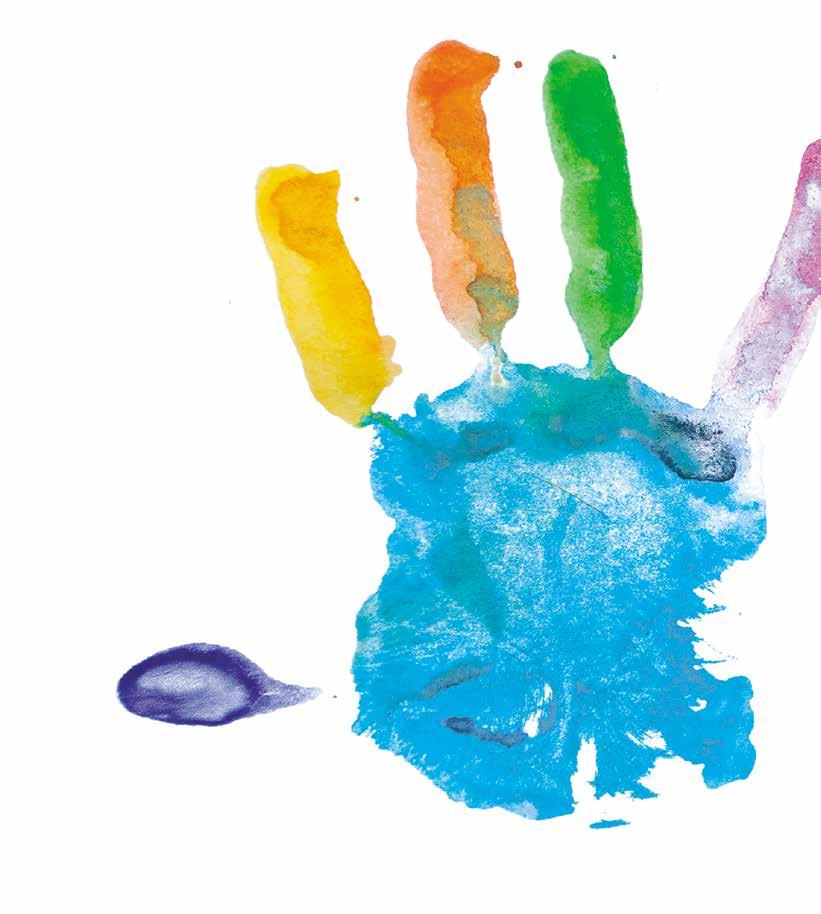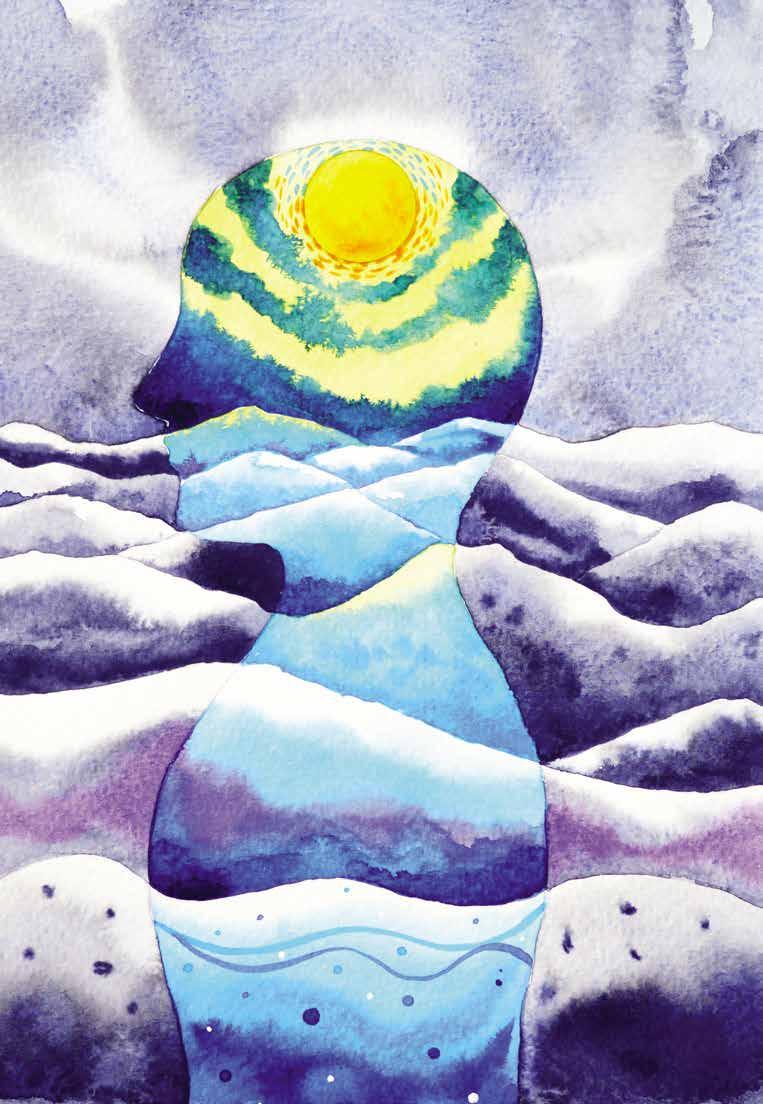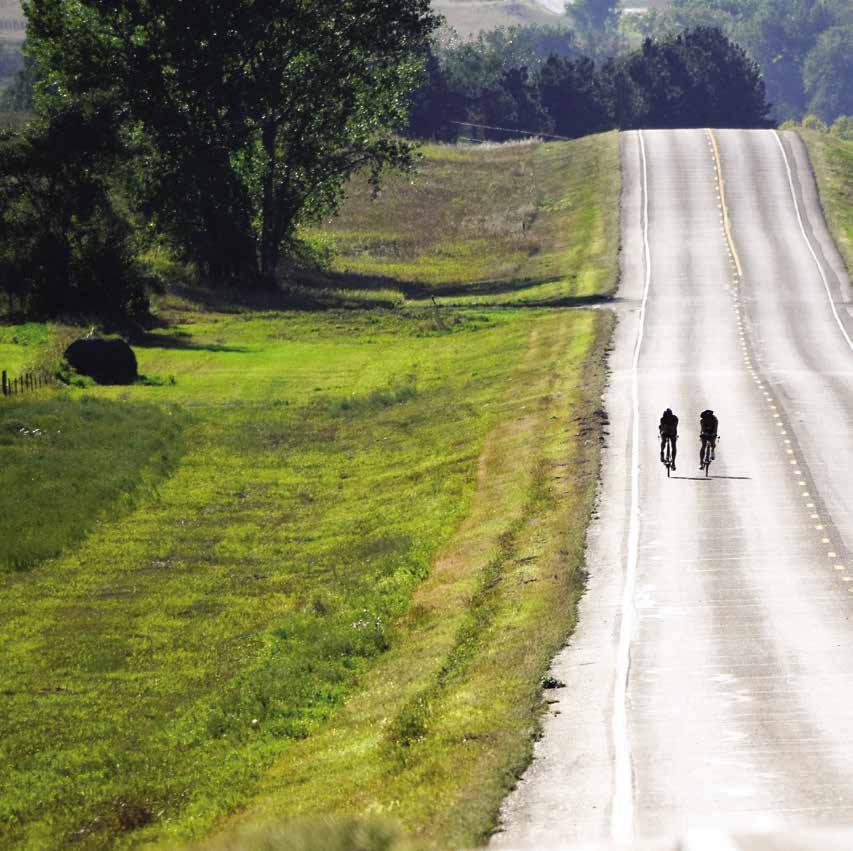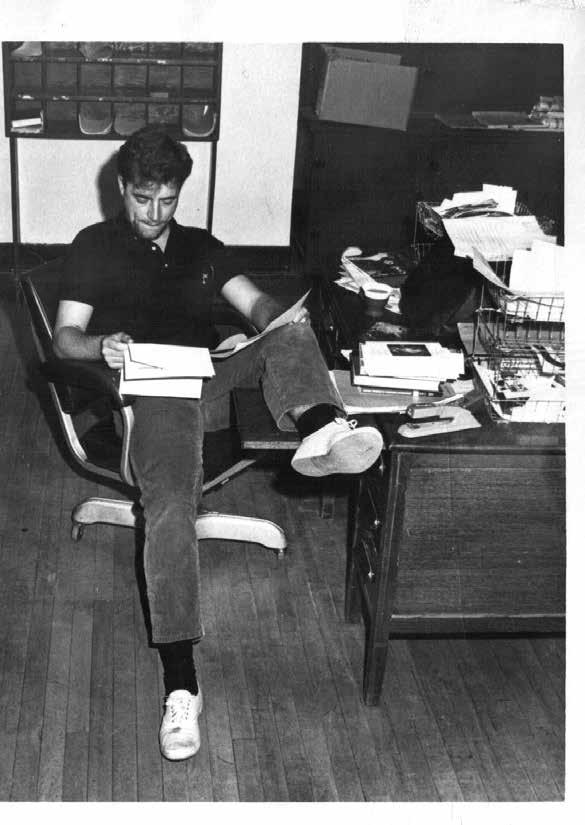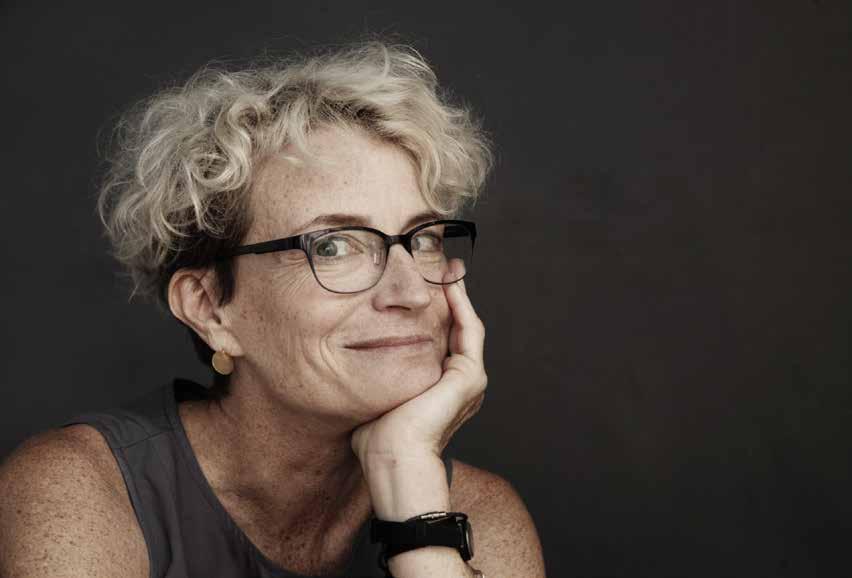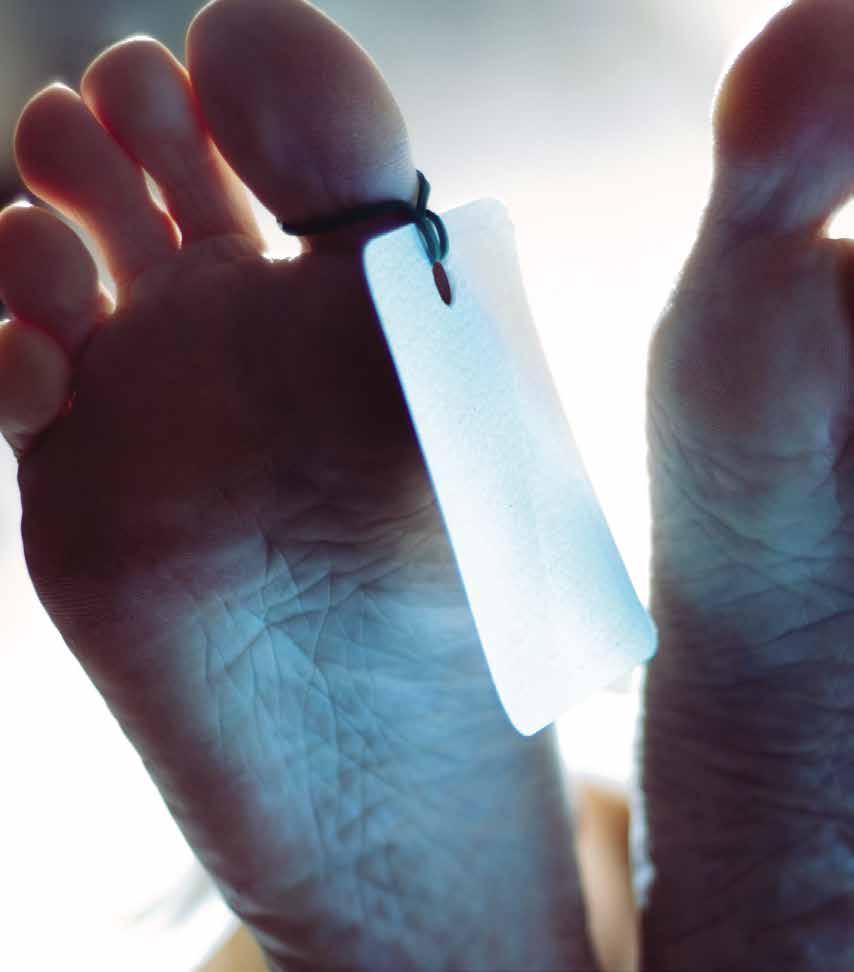
15 minute read
Toothpicks in Jell-O
GAMECHANGER IDEAS FESTIVAL THINKER:
CAITLIN DOUGHTY
Advertisement
Caitlin founded the death acceptance collective, The Order of the Good Death.
Caitlin Doughty is a mortician, activist, and funeral industry rabble-rouser. In 2011, she founded the death acceptance collective The Order of the Good Death, which has spawned the death positive movement.
Her first two books, Smoke Gets in Your Eyes: And Other Lessons from the Crematory, and From Here to Eternity: Traveling the World to Find the Good Death, were New York
Times best-sellers. She lives in Los Angeles, where she runs her nonprofit funeral home, Undertaking LA.
HAVE A QUESTION ABOUT DEATH, DYING, OR THE FUNERAL INDUSTRY?
Caitlin Doughty’s YouTube series, Ask a Mortician addresses these issues and more.

TOOTHPICKS IN JELL-O
by Caitlin Doughty
Though you may have never attended a funeral, two of the world’s humans die every second. Eight in the time it took you to read that sentence. Now we’re at fourteen. If this is too abstract, consider this number: 2.5 million. The 2.5 million people who die in the United States every year. The dead space this process out nicely so that the living hardly even notice they’re undergoing the transformation. We’d probably pay more attention if no one died all year, and then on December 31 the entire population of Chicago suddenly dropped dead. Or Houston. Or Las Vegas and Detroit put together. Instead, unless a celebrity or public figure dies, we tend to overlook the necro demographics as they slip away into history.
Someone must take care of these corpses, who have become useless at caring for themselves. Someone must pick them up from homes or hospitals and transport them to the places we hide bodies—mortuaries and coroners’ offices. In Dante’s Inferno the job fell to Charon, a shaggy-jowled, white haired demon who piloted sinners by boat across the River Styx into hell.
At Westwind Cremation, that job belonged to Chris.
Chris was in his late fifties, tan with a shock of white hair and sad bassethound eyes. He was always impeccably clean and wore khakis and a button-down shirt—California formal wear. I took to him immediately. He reminded me of Leslie Nielsen, star of the Naked Gun movies, which were my favorite as a child.
Chris’s voice was slow and monotonous. He was a bachelor—never married, never had children. He rented a small apartment he would return to in the evening to eat a bowl of ramen and watch Charlie Rose. Chris was pessimistic and borderline curmudgeonly, but in a way that brought me happiness, like watching a Walter Matthau movie.
Picking up a person who has died at home is known as a house call. Doctors may not make them anymore, but morticians are happy to come, day or night. Protocol in the funeral industry says that one person may go alone to pick up bodies from hospitals, nursing homes, and the corner’s office, but a team of two people must pick up a person who died at home. When a house call came in, I was to be Chris’s number two.
I appreciated the two-person rule tremendously. The gurney was the most uncooperative, unyielding machine e’er created by man. It tried, in sinister fashion, to embarrass you in front of your boss by being clunky and useless at every turn. The gurney was the only thing in this world less cooperative then the dead bodies that were strapped to them. The thought on having to operate a gurney alone in someone’s private home was horrifying.
The first house call I went on, a week into working at Westwind, was in South San Francisco. The deceased was Mrs. Adams, an African-American woman in her late forties who had died of breast cancer.
To pick up Mrs. Adams, Chris and I hopped into the van, his version of Charon’s boat. This particular van, which Chris had owned for more than twenty years, was a white, windowless box of a vehicle, the kind they featured in televised public service announcements to remind children not to ride with strangers. Westwind once owned its own removal van— much newer, dark-blue, designed and outfitted with special feature for picking up the dead. But Chris liked routine. He liked his van.
As we drove over the massive Bay Bridge connecting Oakland to San Francisco, I made the mistake of commenting on how beautiful the city looked that day.
Chris was horrified. “Yeah,” he said, “But you live there, so you know once you get up close it’s just a noisy and dirty hell pit. I would be better if we just fire bombed the whole city. That is—if we even make it across.”
“What do you mean if we make it across?” I asked, still adjusting to the concept of fire bombing.
“Think about the way this bridge is built, Cat”—he called me Cat—“crammed up here on eighty-foot Douglas fir pillars just sticking in the mud. It’s like toothpicks in Jell-O, structurally. We’re just swaying up here. The legs could just snap in half like twigs any second, and we’re all dead.”
I laughed at a slightly higher pitch than usual, glancing out the window at the long drop to the Bay below.
We pulled up outside the Adamses’ home twenty minutes later with none of the pomp and pageantry of the funeral carriages of old. In lieu of plumed horses in a cortège, it was Chris and me in his twenty-year-old unmarked white van.
Before we went in, I made Chris go over everything again. I wasn’t about to embarrass myself in front of this woman’s husband.
“Don’t worry about it, Cat. A monkey could do this job. I’ll talk you through it.”
As we got closer to the house, it became clear that we would not be dealing with just the woman’s husband. At least fifteen people were milling around outside, eyeing us suspiciously as we walked up the front path to the door. When we walked through the front door we found ourselves in a high-ceiling living room, where at least forty people were gathered around a woman’s body. Like the scratch of a needle on a skipping record, their voices all went silent at once as the group turned to look at us.
Oh great, I thought, the only two white people here have arrived to take their beloved matriarch away in our roving child-molester van.
Chris, however, didn’t miss a beat. “Hello, folks, we’re here from Westwind Cremation & Burial. Is this Mrs. Adams here?” he asked, gesturing to the dead body in the center of the room.
It was a pretty safe bet to assume that this was, in fact, Mrs. Adams, but the group seemed to appreciate the question. A man stepped out and introduced himself as Mr. Adams.
Quick to prove myself useful, I asked in a solemn tone, “Were you her husband?”
“Young lady, I am her husband. Not were her husband,” he replied, fixing me with a withering gaze, compounded by the forty other withering gazes from around the room.
This is it, I thought. I’m done. I have shamed myself and my family and all is lost.
However, Chris was, again, unfazed. “Well I’m Chris, and this is Caitlin,” he said. “Are we ready to take her, here?”
At this point the family usually leaves the room, leaving the funeral-home employees to do whatever they do with the corpse to make it disappear. But this family wanted to watch us. This meant my first time removing a dead body from a home was going to be in front of forty crying people who hated me.
This was the moment I learned the magic of Chris. He began talking me through the process. He explained how we were going to remove Mrs. Adams as if he were telling the crowd.
“Now we’re going to pull the gurney right alongside the bed, and Caitlin is going to use that handle there to lower her side down. I’m going to take the sheet next to her head and Caitlin is going to take the sheet by her feet and slide it right underneath her. Caitlin is going to pick up her feet onto the gurney in one, two, three. Now she’s going to wrap the second sheet over her head and snap her in tightly.”
This continued until Mrs. Adams was swathed and buckled securely to the gurney. The people in the room paid rapt attention to the process, following Chris’s voice step by step. I was grateful that he didn’t expose me as a fraud. I didn’t even really feel like a fraud. The way Chris explained things made me believe I actually knew what I was doing. Surely there had never been a time I hadn’t been an expert body shrouder.
As we wheeled Mrs. Adams out the front door, her son came up to us. He was my age, and his mother was dead. He wanted to lay a flower on the gurney. I didn’t know what to say, so I blurted out, “She must have been a really amazing woman. Trust me, I can just tell about these things.”
This was, of course, a lie. This was my very first house call and I didn’t know how to properly wrap the body in a sheet, forget measuring the vibe of the room to determine just how “amazing” a dead person was when they were living. “Um, yeah, thank you,” he said. Driving away from the house, Mrs. Adams rattling gently in the back, Chris assured me that I hadn’t actually screwed everything up forever. “Look, Cat, we see people at their worst moments. Maybe if someone’s buying a new car, or a new house, they want to be there. But what are they buying from us? Nothing, we’re charging money to take away someone they love. That’s the last thing in the world they want.” This made me feel better.
Westwind’s two cremation machines could handle six bodies (three in each retort) on a typical 8:30-5:00 day— thirty souls a week during busy periods. Each removal took at least forty-five minutes, far longer if the deceased was across the bridge in San Francisco. By all rights Chris and I should have been out fetching bodies constantly. Chris was out constantly, but often just to avoid Mike (our boss) by volunteering to run petty errands like picking up death certificates and going to the post office. I mostly stayed at Westwind and focused on cremation, since the majority of body pickups didn’t require a number two. Most deaths no longer happen at home.
Dying in the sanitary environment of a hospital is a relatively new concept. In the late nineteenth century, dying at a hospital was reserved for indigents, the people who had nothing and no one. Given the choice, a person wanted to die at home in their bed, surrounded by friends and family. As late as the beginning of the twentieth century, more than 85 percent of Americans still died at home.
The 1930s brought what is known as the “medicalization” of death. The rise of the hospital removed from view all the gruesome sights, smells, and sounds of death. Whereas before a religious leader might preside over a dying person and guide the family in grief, now it was doctors who attended to a patient’s final moments. Medicine addressed life-and-death issues, not appeals to heaven. The dying process became hygienic and heavily regulated in the hospital. Medical professionals deemed unfit for public consumption what death historian Philippe Ariès called the “nauseating spectacle” of mortality. It became taboo to “come into a room that smells of urine, sweat, and gangrene, and where the sheets are soiled.” The hospital was a place where the dying could undergo the indignities of death without offending the sensibilities of the living.
In my high school, my classmates and I had been told in no uncertain terms that we would not get into college and thus would never get a job and thus would end up unsuccessful and alone if we didn’t serve a certain amount of summer volunteer hours. So the summer between my sophomore and junior years, I signed up to volunteer at Queen’s Medical Center, a hospital in downtown Honolulu. They confirmed I was not a drug user and had decent grades, and gave me a hideous brightyellow polo shirt and a name tag and told me to report to the volunteer office. The volunteer department allowed you to select two areas of the hospital to rotate between from week to week. I had no interest in popular choices like the gift shop or the maternity ward. “Get Well Soon” balloons and crying babies seemed like a cloying, sappy way to spend the summer. My first choice was working the front desk at the intensive car unit, imagining a glamorous-nurse-wiping-fevered-brows scenario out of World War II.
The ICU was not the thrill ride I had expected. Turns out, they never called the high school student in from the reception desk to assist doctors in lifesaving procedures. Instead, the job entailed hours of watching incredibly worried families wander in and out of the waiting room to use the restroom and retrieve cups of coffee.
I had more success with my second choice, the distribution department. Working for the distribution department meant passing out mail and memos to different wings of the hospital or wheeling old women out to the front curb after they were discharged. But it also meant transferring dead bodies from wherever they had expired to the morgue in the basement. I coveted that task. The people who worked full-time in the department may not have understood my enthusiasm, but when there was a “code black” called for a corpse transfer, they would generously wait for me to arrive.
In retrospect, it seemed odd that the hospital administration would say, “Sure thing, fifteen-year-old volunteer, you’re on corpse transfer duty.” I can’t imagine this was something they normally assign to young volunteers. In fact, I recall a fair amount of initial reluctance on their part— overcome by my successful begging.
Kaipo, my direct supervisor, a young local Hawaiian man, would look at the board and declare in his thick pidgin accent, “Eh, Caitlin, you like come get Mr. Yamasake from Pauahi Wing?” Oh yes, I most certainly did want to get Mr. Yamasake. Kaipo and I arrived in Mr. Yamasake’s room to find him curled up in the fetal position on his immaculate white hospital bed. He looked like a museum mummy, with taut skin like brown leather. He was less than ninety pounds, desiccated by disease and old age. Either one of us could have lifted him onto the stretcher with one hand.
“Dang, dis guy’s pretty old, yeah?” Kaipo said, Mr. Yamasake’s age surprising even a veteran of the corpse–transfer beat.
The stretcher Kaipo and I had brought with us was actually a hollowed-out metal cage. We placed Mr. Yamasake inside before covering him with a stainless steel top, like a lid. A white sheet was draped over the whole operation. Kaipo and I left Mr. Yamasake’s room pushing what appeared to be an empty stretcher.
We rolled into the elevator with regular hospital visitors holding their teddy bears and flowers, none the wiser about the secret corpse in their midst. (The next time you see two fullgrown adults moving an unoccupied stretcher in a hospital, think of Mr. Yamasake.) The others got off the elevator long before we did. Kaipo, Mr. Yamasake, and I continued down to the basement.
The hospital presented itself as a positive place of healing with the latest technology and attractive Hawaiian art prints on the walls. Everything—the false stretcher, the secret morgue in the basement—was artfully designed to mask death, to distance it from the public. Death represented a failure of the medical system; it would not be permitted to upset the patients or their families.
Kaipo and Chris from Westwind were kindred spirits in a way: two men of quiet dignity who transported the husks of the recently alive. To them it was a prosaic day job, while to the average citizen theirs was a task both mystifying and disgusting.
A few weeks after our trip to the Adamses’, Chris and I took a house call in the Marina District of San Francisco at a fancy home on a well-trafficked street.
When we knocked, a dark-haired woman in her fifties opened the door. I gave her a big, sincere smile, having learned at that point that a sincere smile was more effective then faked sympathy.
“I called you hours ago!” she shrieked.
“Well, ma’am, you do know that it is rush hour and we were coming from Oakland,” Chris said in his soothing Chris voice.
“I don’t care, Mom deserves the best. Mom would have wanted everything to be dignified. She was a dignified woman, this is not dignified,” she continued, still shrieking.
“I’m sorry ma’am, we’ll take good care of her,” Chris said.
We continued into a bedroom to find Mom. As we pulled out the sheet to shroud her, the woman hurled her body over her mother, wailing dramatically. “No, Mother, no, no! I need you, Mother, don’t leave me!”
This is what raw human emotions should look like. It had all the signs: death, loss, gut-wrenching wailing. I wanted to be moved, but I wasn’t. “Guilt,” Chris mumbled under his breath.
“What?” I whispered back.
“Guilt. I’ve seen this so many times. She hasn’t visited her for years. Now she’s here acting like she can’t live without her mother. It’s bullshit, Cat,” he said. And I knew he was right.
The woman finally extricated herself from mother’s corpse, and we were able to get Mom wrapped up and out the door. As we rolled the gurney out onto the busy street, people stopped and stared. Dog walkers halted and yoga moms slowed their baby carriages. They gawked at us as if we were detectives or coroners, pulling a body from a violent murder scene, not two mortuary workers handling a woman in her nineties who had died quietly at home in bed.
For the few minutes it took Chris and me to roll “Mom” from her front door to the back of the van, we gave the dog walkers and yoga moms a cheap, manageable thrill. A whiff of depravity, a small taste of their own mortality.
Adapted from Smoke Gets in Your Eyes by Caitlin Doughty. Copyright © 2014 by Caitlin Doughty. With permission of the publisher, W. W. Norton & Company, Inc. All rights reserved.



